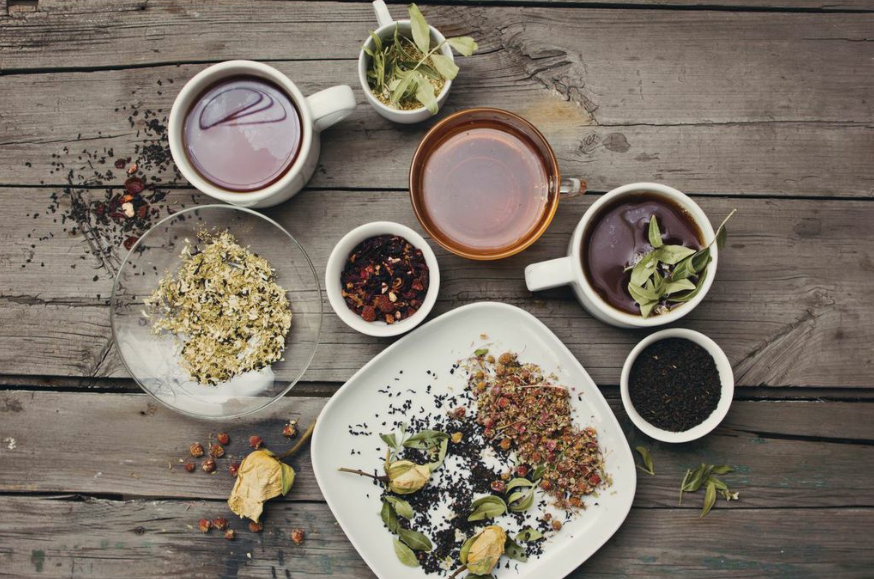Where I live, winter is coming… The sun is still out there, but temperatures are dropping so fast these days. For me, this is the time of the year to prepare some healing, herbal tea blends to soothe and prevent cold or flu.
It may still be warm where you live, but don’t wait till you start to feel cold or flu symptoms coming up. You can buy the loose tea leaves or dry them yourself straight from the garden. Here are some different homemade herbal tea recipes to get you through the season.
Cold & Flu Fighting Tea Recipes
#1 Sore throat Blend
A sore, dry and painful throat is often the onset of a cold or flu. Herbal teas can help you to prevent an outbreak and soothe your throat.
- 1 part slippery elm (antiseptic and anti-allergic agent)
- 1 part licorice root (antibacterial, antiviral and anti-inflammatory, soothes the throat and works excellent for bronchitis, also adds a sweetening effect)
- 1 part marshmallow root (anti-inflammatory herb, soothes irritable coughs)
- 1 part anise (soothes a sore throat and cough)
- ¼ part wild cherry (relaxes bronchial muscles, soothes a sore throat and cough)
Mix all those herbs to prepare your own stash at home. When having a sore throat, steep 2 teaspoons in a cup of hot water.
#2 Easy Breathe Blend
Great lung opener when having difficulties to breathe. The caffeine in the oolong tea works as an excellent bronchodilator.
- 2 parts oolong tea (helps to clear mucus)
- 1 part rosemary (contains disease-fighting compounds)
- 1 part chamomile (anti-inflammatory, antibacterial, antifungal, antiseptic and antispasmodic)
- 1 part rose hips (for the taste and high levels of vitamin C)
Place 2 teaspoons of the blend in a strainer and add one cup of hot water. Steep for 10 to 15 minutes.
#3 Herbal Bedtime Tea
This mixture is ideal to aid in a more restful sleep when suffering from a cold or flu.
- 1 part sage leaves (clear the respiratory functions quickly and efficiently
- 1 part catnip (causes sleepiness, reduces fevers)
- 1 part peppermint leaves (clears respiratory system, reduces fever, soothes an upset stomach)
Add 3 tablespoons of tea mixture to 1-quart hot water. Steep for 15 to 30 minutes. Strain the leaves from the water and, if you like, add some honey and the juice of 1 lemon.
#4 All-around Soothing Blend
This mixture is based on Echinacea and makes an excellent any time of the day or night tea to soothe colds.
- 2 parts Echinacea roots or flowers (immune boost to fight cold virus)
- 1 part blackberry leaves (relieves a chronic cough and respiratory congestion)
- 1 part blueberry leaves (relieves a chronic cough and respiratory congestion)
- 1 part elder flowers (reduces fever, relieves a chronic cough and respiratory congestion)
Bring a quart of water to a gentle boil. Place 5 tablespoons of the mixture into the hot water. Lower the heat and simmer for 15 minutes. Strain the leaves before serving.
Scroll down for more tips on how to tweak and store your tea blends.

Experimental Tips
There are many herbs to aid you when suffering from a cold or flu. Those are some of the recipes for you to try. But experiment with the herbs of your liking and prepare your own healing blend mixture.
Here’s a list of some more healing herbs that are well-known for their soothing and healing effects when it comes to colds or flu.
- Cinnamon (increases perspiration, good for diarrhea and nausea)
- Fennel (expectorant, soothes a sore throat and coughs)
- Ginger (fights rhinoviruses (colds), increases perspiration, reliefs pain, fever, nausea, and diarrhea, suppresses coughs, calming effect)
- Green tea (prevents infections)
- Lavender (expectorant)
- Maitake (kills viruses)
- Mullein (anti-inflammatory, expectorant)
- Raspberry leaves (diarrhea)
- Skullcap (stops reproduction of viruses, calm and sleepy effect)
- Thyme (antispasmodic, soothes coughs and colds, antibacterial and antifungal)
- Yarrow (reduces fever and diarrhea)
How To Store
Now that you’ve done all the work and made those homemade herbal tea recipes, your work is not done. It is very important to store them properly. If you do so, they have a shelf life up to one year.
Loose tea leaves need to be kept away from heat, light, air, and moisture. Heat, light, and air are the main reasons why your tea will become stale before its time. So opt for an airtight non-clear container and store them in a cool and dry spot in your house.
You can keep them in a glass jar if you like, but make sure to store them in a cabinet away from the sun’s UV rays.
Keep away from moisture to prevent the tea leaves from rotting and molding. Do not store tea in the refrigerator, as some people say. The fridge is full of odors and moist and tea leaves are an excellent absorber… So not a good idea to store them in the fridge if you ask me.
For The Sweet Tooth
A lot of people like their tea a bit sweeter. If you are one of those people, try to avoid refined white sugar but try some healthy natural sweeteners instead. They have fewer calories and lower the risk of sugar-induced ailments.
Here are some good and natural alternatives for you to try:
- Agave syrup, 50 % sweeter than white sugar but fewer calories per serving. Its flavor is more neutral than honey and dissolves well in cold water as well.
- Raw honey, my liquid gold. Nutritive, jam-packed with vitamins, minerals, antioxidants and amino acids. On top of that, it has antibacterial properties, which is perfect for your winter tea recipes.
- Blackstrap molasses, derived from sorghum and considered as a healthy food since the old days. High in minerals (iron, calcium, potassium, and magnesium).
- Stevia, 100 times sweeter and calorie-free. Studies show a positive effect on blood sugar levels, making a good alternative for diabetics.
What are your favorite healing tea blends? Feel free to share them in the comment box below.
Thanks for reading. I hope this information was helpful. Until next time!

Amy Goodrich
Crazy cat lady, life and food lover, certified biologist, and holistic health coach.




